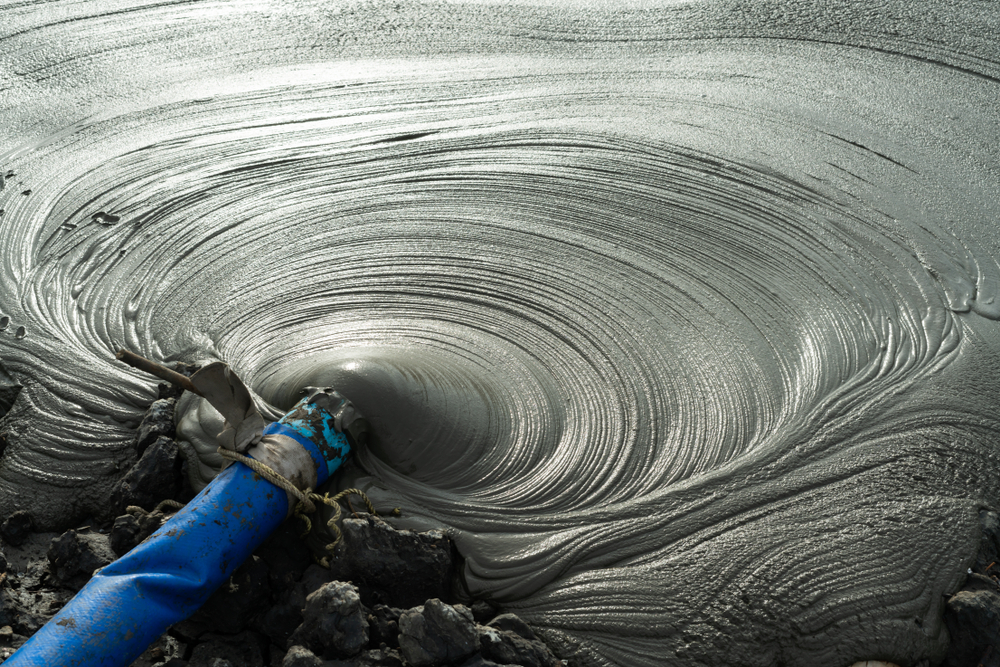IP 423 Solid Sediment in Drilling Fluids Test
The IP 423 solid sediment test is a critical procedure used to ensure that drilling fluids, or muds, meet the stringent quality standards required for oil and gas operations. This test measures the amount of solid particles suspended in the drilling fluid, which can significantly impact the efficiency and safety of drilling operations.
Drilling mud serves multiple purposes during well construction: it cools down the drill bit, provides hydrostatic pressure to prevent formation fluids from entering the borehole, suspends cuttings, and aids in cementing. The presence of excessive solid particles can lead to reduced filtration efficiency, increased weight, and higher viscosities, all of which can compromise drilling performance and safety.
According to ISO 28107:2015, the method for determining the solid sediment content in mud is widely recognized. The test involves sampling the drilling fluid from a specified location within the rig, typically at the bottom of the casing or during circulation. Proper specimen preparation ensures that the sample accurately represents the overall properties of the drilling fluid.
The laboratory uses advanced analytical equipment such as centrifuges and sieves to separate the solid particles from the liquid phase. The process involves drawing a known volume of mud into a suitable container, followed by a series of steps where the mixture is subjected to gravitational force or mechanical filtration. This method ensures that the solid sediment content can be quantified accurately.
The results are reported in terms of weight percentage based on the initial volume of mud sampled. Compliance with industry standards like ISO 28107:2015 and API Spec Q1 is crucial to ensure consistent quality and reliability across different projects. The test not only helps in maintaining operational efficiency but also ensures that environmental impacts are minimized by preventing the release of excess solids into the surrounding environment.
The importance of this testing cannot be overstated, especially in deepwater drilling operations where the integrity of the wellbore is paramount. By adhering to these standards, operators can ensure that their drilling fluids meet the highest quality benchmarks, thereby enhancing safety and operational effectiveness.
Why It Matters
The solid sediment content in drilling mud plays a pivotal role in the performance of oil and gas operations. Excessive solids can lead to several issues that affect both the efficiency and safety of drilling activities:
- Filtration Efficiency: High levels of solid particles reduce the filtration efficiency, leading to increased pressure drops across filters.
- Mud Weight: Solid sediment increases the mud weight, which can lead to an increase in the hydrostatic pressure exerted on the wellbore, potentially causing blowouts.
- Viscosity: The presence of solids can significantly raise the viscosity of the drilling fluid, making it harder for the drill bit to cut through rock formations efficiently.
The consequences of not adhering to the solid sediment content standards can be severe. Inadequate control over this parameter may result in operational disruptions and increased costs due to repairs or re-drilling. Moreover, there is a risk of environmental contamination if excess solids are discharged into nearby water bodies.
Compliance with industry standards like ISO 28107:2015 ensures that the drilling fluid meets the necessary quality benchmarks, thereby enhancing operational efficiency and safety. This not only contributes to the overall success of oil and gas projects but also helps in maintaining a sustainable approach to resource extraction.
Quality and Reliability Assurance
- Consistent Compliance: Ensuring that all samples are tested according to ISO standards guarantees consistent results across different batches of drilling fluid.
- Data Accuracy: Advanced analytical equipment like centrifuges and sieves provide precise measurements, minimizing the margin for error in determining solid sediment content.
- Eco-Friendly Practices: By adhering to these standards, operators can minimize environmental impact by reducing the release of excess solids into the surrounding area.
The laboratory's commitment to quality and reliability is reflected in its adherence to international standards. Using precise equipment and following rigorous protocols ensures that every test result is accurate and reliable. This approach not only enhances operational efficiency but also contributes to environmental sustainability by minimizing waste and preventing contamination.
Use Cases and Application Examples
The IP 423 solid sediment in drilling fluids test is a cornerstone of quality assurance in the oil and gas sector. Its application spans various stages of exploration, drilling, and completion:
- Exploration Drilling: During initial exploratory drilling, monitoring solid sediment content helps in selecting the appropriate mud type for future operations.
- Drilling Operations: Regular testing ensures that mud weight and viscosity are optimized throughout the drilling process.
- Cementing Operations: Ensuring the correct solid content is crucial during cementing to achieve a strong bond between the casing and the formation.
In addition, this test is essential for compliance with environmental regulations. By adhering to standards like ISO 28107:2015, operators can ensure that they meet both operational and regulatory requirements, thereby reducing the risk of fines or other penalties.
The real-world application of this testing ensures that oil and gas operations are conducted in a safe and efficient manner. By maintaining consistent quality standards, operators can enhance their reputation for reliability and sustainability, which is critical in today's competitive market.





